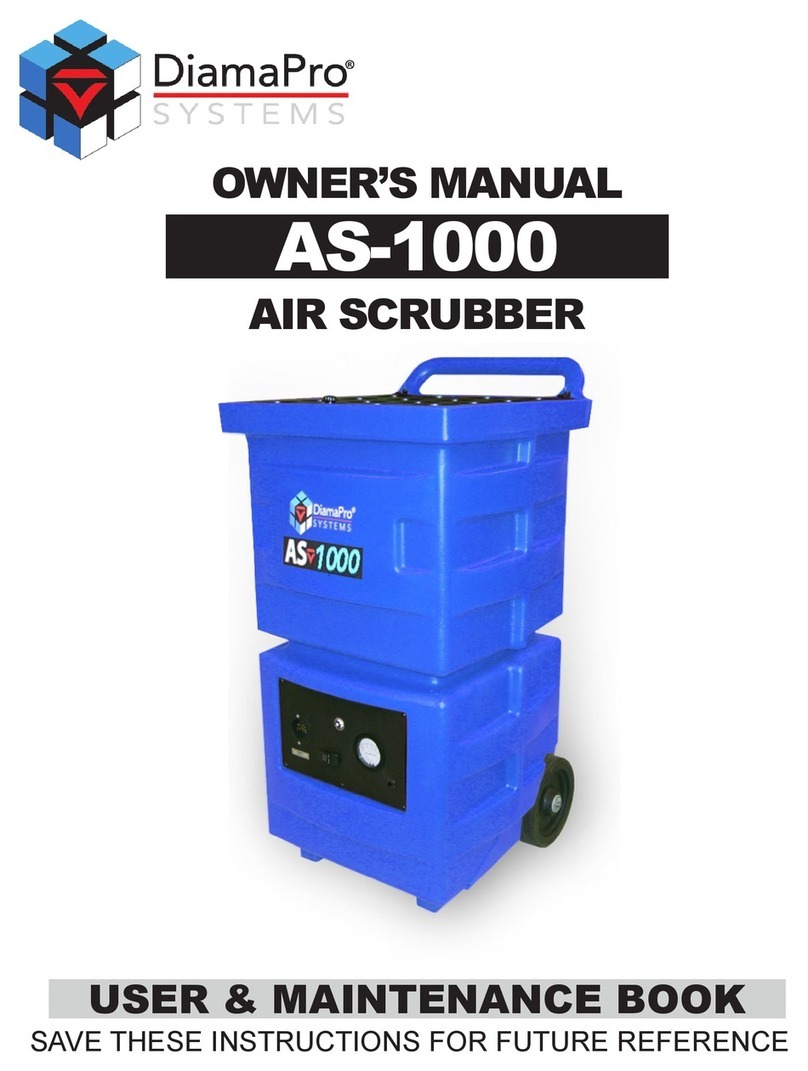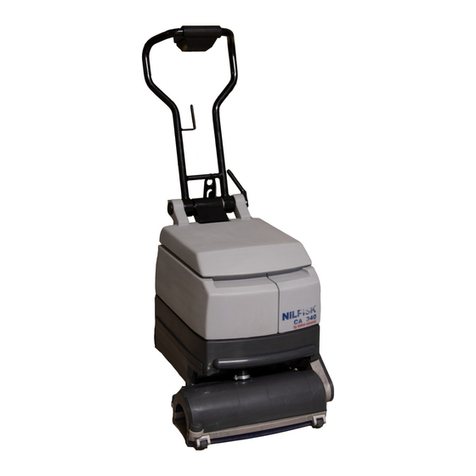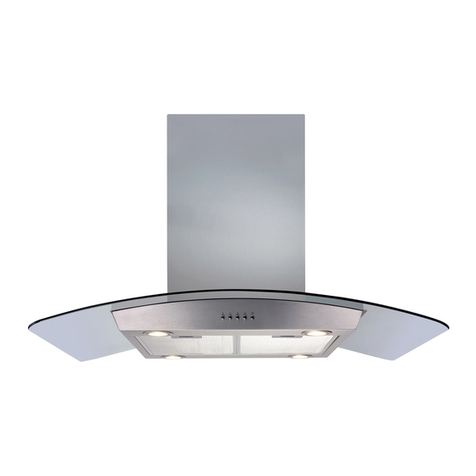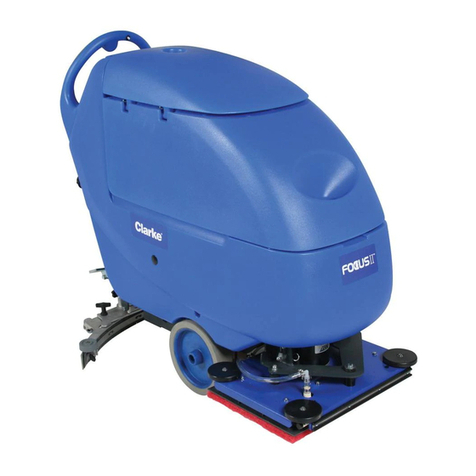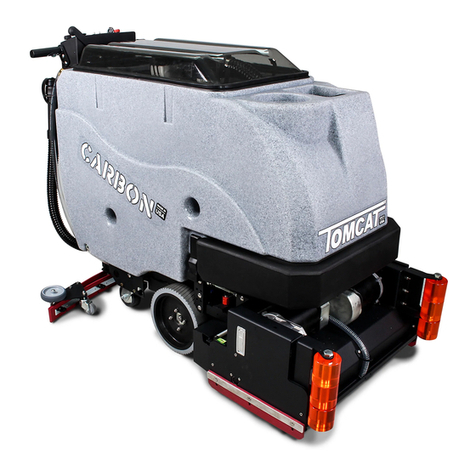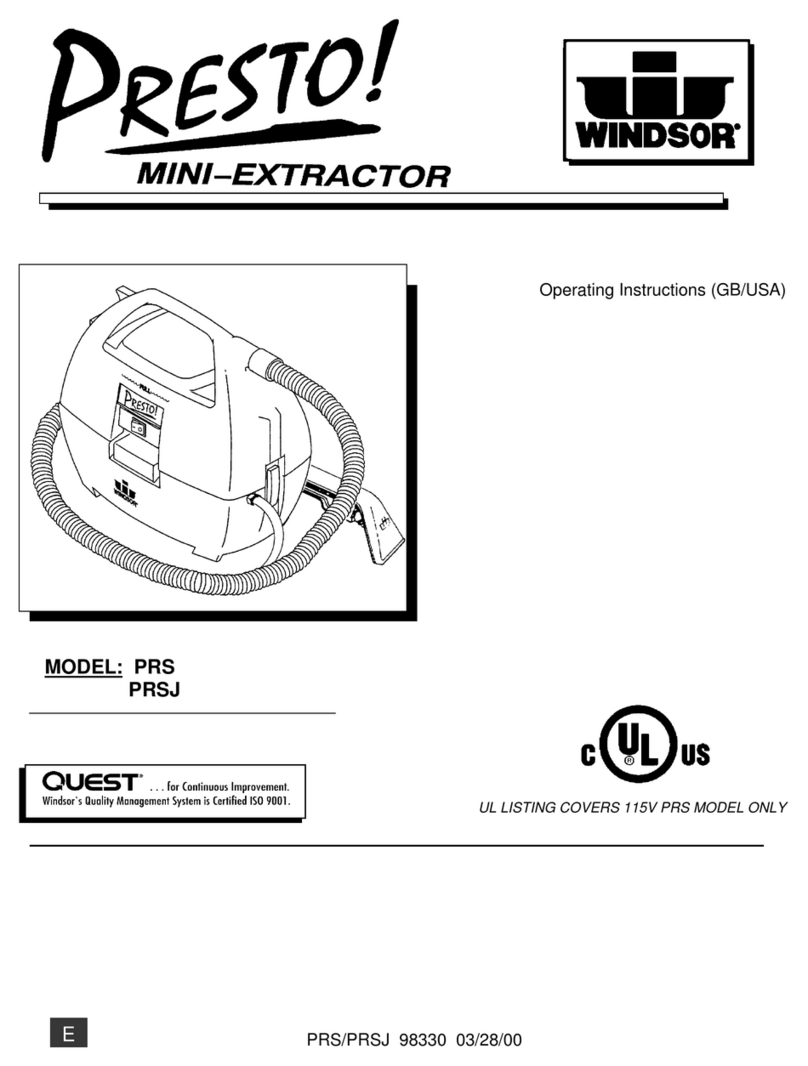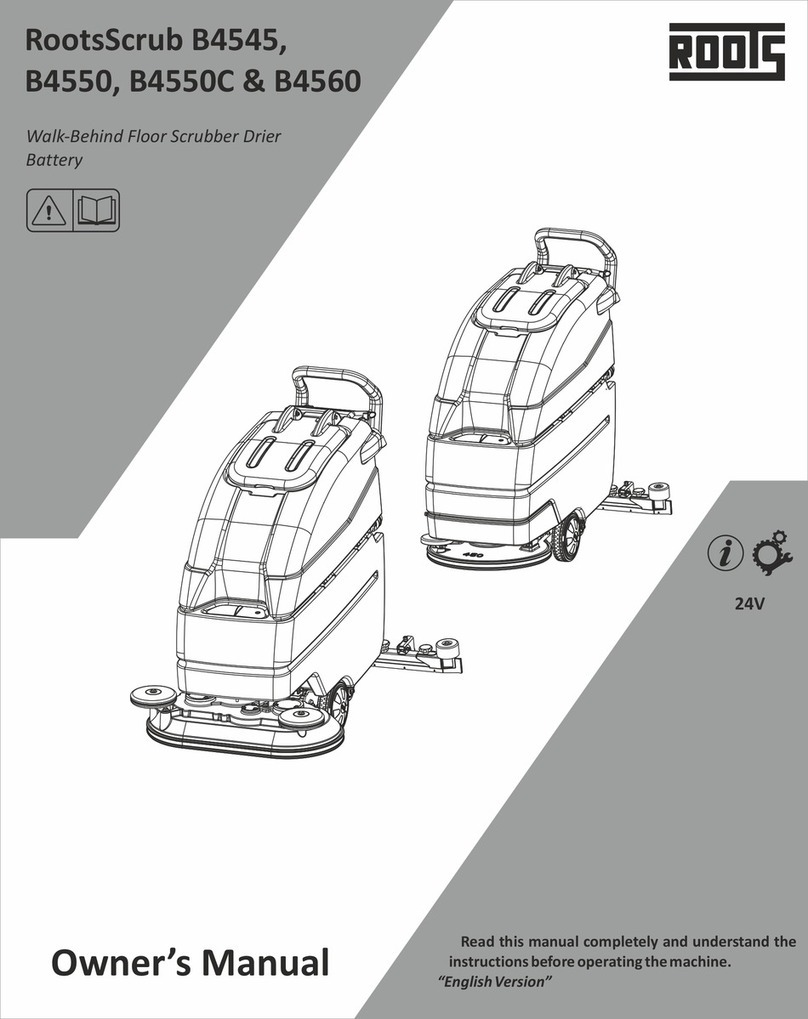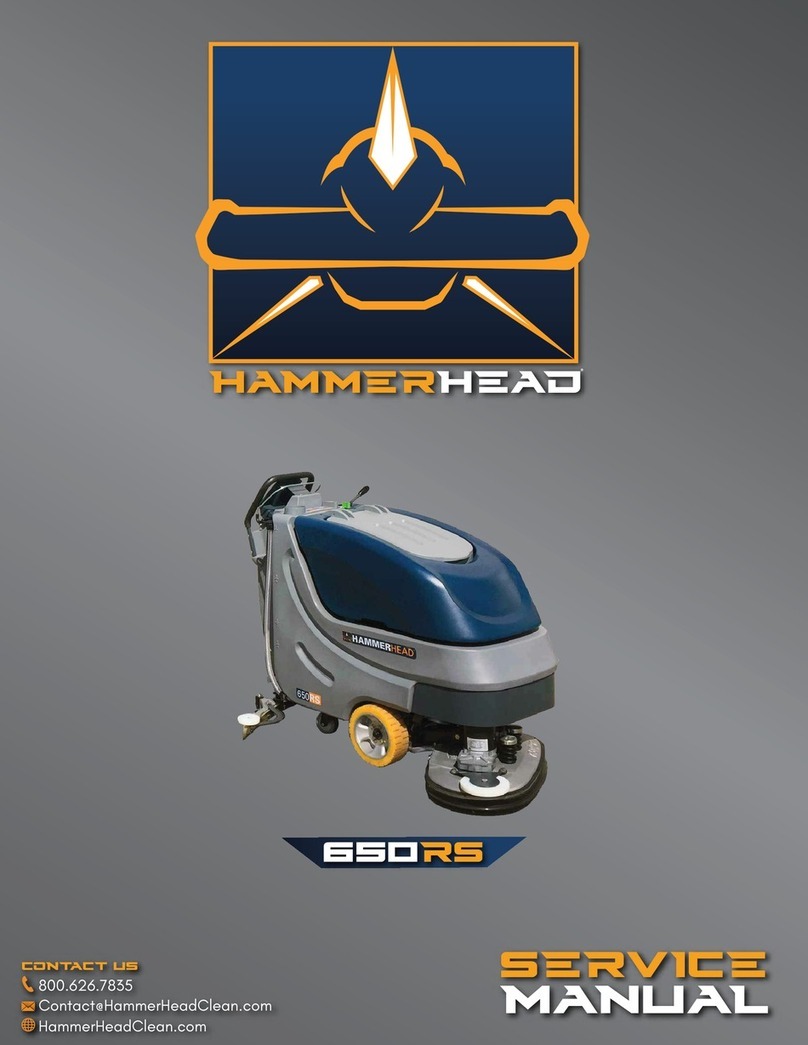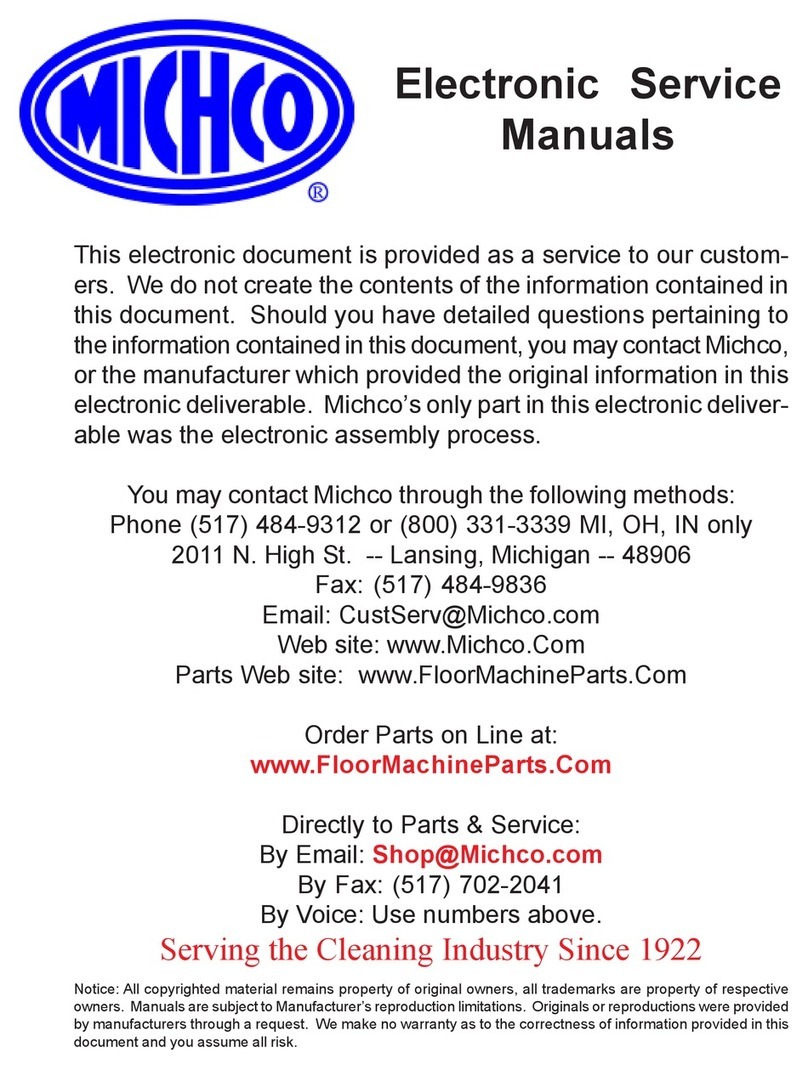DiamaPro Systems DP-SCRUB20 User manual

OWNER’S MANUAL
DP-SCRUB20
AUTO SCRUBBER
USER & MAINTENANCE BOOK
SAVE THESE INSTRUCTIONS FOR FUTURE REFERENCE

OPERATIONAL SAFETY INSTRUCTIONS
Thank you for purchasing our products. This operation manual will provide you with a comprehensive
guide to operate this machine. Please read this manual carefully before you use the machine and
retain it for future reference.
Please read this manual carefully before using this appliance.
In this manual, there are common safety instructions in detail on appliance preparing, operating and maintenance. The
operator must obey these accident-preventive regulations when using this machine. The manufacturer does not bear any
liability for any accident caused by disobeying these regulations.
This manual is one of the most important pieces of this appliance. Ensure the operator reads or listens to the manufactur-
er’s introduction on this manual. Save this manual where you can easily fetch and read regularly. This manual adopts the
following three kinds of gure as the important indication:
INDICATION:
Key information on economical using.
The possible accident caused by disobeying the manual.
NOTICE:
The possible accident and estate damage caused by disobeying the manual
FORBIDDEN
The possible severe damage to person and estate caused by disobeyed instruction.
SAFETY NOTICE
In case any operation is conducted before reading through the manual, the casualty to the operator or others, and
even the damage to the machine might be unavoidable. No operation will be permitted without prior training and
demonstration
To reduce the risk of re, this machine is only appropriate for cleaning explosion-proof commercial oorings.
Half-installed or half-t machine might cause damage to the operator or others, and might also cause casualty to
the machine or parts of the machine. Before tting it in completely, do not conduct any operation on the machine.
Before operation, one should make sure all components of the machine are well-preserved.
The maintenance of this machine should be performed by trained and qualied technicians. Before maintenance,
unplug the machine from the power outlet for the sake of avoiding more harmful interferences.
Check the batteries, and make sure that the + and – on the batteries are aligned according to the polarity diagram.
After it is conrmed that no mistake is made, the battery outlet can be connected to the machine.
This machine is to be charged by DC power supply and thus the + and – on the batteries must never be mis-
aligned. Otherwise, all electric apparatuses of the machine will be damaged.
All storage batteries of various types or brands should have their own appropriate charging units. Mismatching
dierent types of battery chargers may cause battery damage or explosion.
The maintenance service to this machine should be performed by trained and qualied technicians. Otherwise,
the machine could be damaged. Since each machine has been tested prior to delivery to guarantee operation on
system test, the professional technicians should make sure that all replacement parts or the repaired parts are on
xed connection after inspecting the defects or damages, and parts claimed for adjustment should be xed again
after the maintenance service.

The electric components of the machine could short circuit when in contact with water or in moist environments.
In order to ensure the desiccation of the components, the machine should be wiped and kept in a dry environment
after being used.
Ensure proper ventilation, especially in the area where the batteries are charged. The charger should be equipped
with an earth lead connecting through the power supply of three cord wire. For the sake of avoiding electrical shock
hazards, it is highly recommended that a leakage circuit-breaker be pre-installed.
Do not recharge the batteries unless the electric platform truck has been pulled out and the cell cover has been
removed (with the exception of the maintenance free battery), since gas bubbles might appear during the process
of recharging. Each time after recharging, remember to ret the cell cover to avoid the spilling of acid liquid.
Do not put any article on the batteries!
Do not put any article on the handlebar!
While cleaning the machine, do not run water into the air inlet of the lift pump!
Safe and economical operation of the machine is only possible if the machine operators are thoroughly familiar
with the signs and contents on this Operator’s Manual. Failure to do so could be harmful.
This machine is inappropriate for cleaning rough oors and slopes; Operators cannot sit on the machine while
operating it in these circumstances.
Be aware not to have your hands, legs, or loose clothing in contact with the rotating part of the machine.
Put warning signs on the surrounding area during operation to inform the operator and others that the oor could
be wet with water or detergents.
Follow safety rules at all times during the process of transportation of this large machine.
CAUTION
Avoid starting the machine or charger where combustible gas or liquid is available.
Avoid laying or placing the machine where combustible gas or liquid is available.

DIAGRAMS OF THE MACHINE
1. Handlebar
2. Control Panel
3. Suction Motor Button (b)
4. Brush Motor Button (c)
5. Power Switch
6. Timer
7. Socket for Charger
8. Squeegee Height Adjusting Handle
9. Manual Pressurized Handle
10. Brush Pedal
11. Guard Wheel
12. Fixed Handle of Squeegee
13. Squeegee
14. Regulating Handle of Squeegee
15. Water Suction Pipe
16. Water Drain Out Pipe
17. Water Valve
18. Metal Frame
19. Wheel
20. Brush
21. Clean Water Filtration
22. Water Level Indicator
23. Solution Tank
24. Dirty Water Tank
25. Dirty Water Tank Cover
a. Battery Indicator
b. Suction Motor Button
c. Brush Motor Button
d. Brush Install and Release Button
e. Rate Regulation (slow) Button
f. Rate Regulation (fast) Button
g. Rate Indication
h. Indication of Operation of Brush
Motor
i. Indication of Operation of Suction
Motor

FUNCTIONS AND NOTES
FUNCTION
DP-SCRUB20 is suitable for ceramic tile ooring, marble ooring, epoxy ooring, PVC ooring, diamond ooring, terrazzo
ooring, concrete ooring and hard oor cleaning. It has an 18-inch brush or pad driver to clean the oor, and the dirty
water will be sucked into a recovery tank by the squeegee. Cleaning is nished after passing over the oor one time. The
best feature of this machine quick dirt removal from the oor and it only requires one person.
ATTENTION
1. This machine is a high-eciency, hard oor scrubber with clean and suction function, but no sweep function. In order
to avoid any tangling and blockage, sweep the oor before operation.
2. This machine is suitable for smooth, hard oor cleaning. If you attempt to clean tile oor with gaps or a rough marble
oor, although this scrubber can remove dirt, it can not absorb the dirty water completely as it would on a smooth
oor.
3. This machine is designed for smooth, hard oors. In order to avoid any potential risk, do not walk and operate on an
inclined plane.
4. Store and park the machine on the horizontal surface. Inexperienced people are forbidden to operate the machine.
5. Do not start or store the machine in an area with ammables, explosives, and chemical medicine.
6. Operator is forbidden to wear slippers or be barefoot.
7. Do not put hands or feet under the moving brush pad.
8. Keep the electrical control parts away from water and any other liquid, it is useful to wipe the machine with a wet
cleaning cloth.
9. Maintenance and amendment should be done by professional personnel.
FUNCTIONS AND NOTES
Battery-powered and equipped with an automatic walking device, The DP-SCRUB20 is a professional oor-cleaning
machine with following characteristics:
1. Simple operation
All actions including accelerating, stopping or retreating can be conducted by operating on the same handlebar. When
this machine retreats to its limiting position, its emergency stop switch will drive the machine in the opposite direction
after being pressed by the operator, so as to prevent the operator from being injured.
2. Power indication
Power can be indicated by dierent colored LCD, so that the operator is informed of the work load.
3. Convenient maintenance
The recovery tank is detachable, you can take it o from the machine, which is convenient for cleaning. You can rinse
the lter by screwing the oating frame. Or you can drain out the water in the solution tank separately, which is conve-
nient for machine maintenance.
4. The dirty water tank cover is transparent, for easily checking tank levels. The transparent water level pipe clearly
shows the water level. The suction motor is xed under the dirty water tank for silent cleaning.
5. Pressurized function makes cleaning much easier, even for a oor with heavy dirt.
6. Convenient for maintenance
Squeegee replacement is quick and convenient.
Loosen the two xed squeegee knobs in the suction squeegee, pull o the suction hose connection, then take o the
suction part. Replace the back squeegee by loosening the fastener. Reverse the upper and lower to reuse the squee-

SPECIFICATIONS
MODEL
WORKING WIDTH OF BRUSH DISK (in)
WORKING WIDTH OF SQUEEGEE (in)
SOLUTION TANK CAPACITY (gal)
RECOVERY TANK CAPACITY (gal)
BRUSH SPEED (rpm)
BRUSH PRESSURE (lbs)
VOLTAGE (V)
SUCTION MOTOR (W)
BRUSH MOTOR (W)
MAGNETIC VALVE POWER (W)
BATTERY CAPACITY (AH)
WEIGHT (lbs)
TRANSPORTATION PACKAGE SIZE (in.)
DP-SCRUB20
20
30
13
15
200
77
24
24V 550W
24V 750W
24V 12W
2x12V / 100
238
51x25x40
BEFORE FIRST USE
1. In order to avoid harmful interference, the machine
should be removed from the package carefully and
the accompanying documents and spare parts
should be checked with great care.
2. Only after having a full understanding towards the
content of operator’s manual, the operator can
handle this machine. (A specic person should be
assigned to operate this machine)
3. The sales engineer or distributor will introduce how
to control the handle bar.
4. Align the battery and make sure that the batteries
and output device are correctly connected. Never
make a mistake on the polarity of the battery. The
batteries can be connected with the power only
after the connection of batteries is conrmed to be
right. (This operation can be carried out only after
the on-spot inspection has been made by the sales
engineer.)
5. Connect the squeegee to its frame, then screw
down xed handle and connect the tube to the
machine connection.
6. Take out the brush disk or needle bed and then
choose a proper brush disk or cleaning pad to
prepare for installation in accordance with the oor
condition.
7. With the lock open, the function test is carried on to
observe whether the power display and function keys
are normal. Only after further tests show nothing
wrong, the next operation can be implemented.
8. Pour water into the solution tank and then add proper
amount of cleaners; install the brush disk.
9. Loosen brake pedal.
10. Turn on power switch.
11. Lay down the squeegee and brush disk.
12. Start the suction motor and brush motor.
13. Pull the water valve switch upwards to regulate the
water output.
14. The clean-out operation can be carried out by push-
ing forward the control handle as well as adjusting
the walking rate.
15. After cleaning, the brush motor and water absorption
motor should be turned o one after another.
16. Uplift the brush disk, squeegee and drain the dirty
water out. The machine should be cleaned and main-
tained according to requirements on the operator’s
manual if a whole day’s work is nished.
17. Move the machine to the parking place, turn o the
power and push down on the brake pedal.
New machines should be operated according to the following procedures during its rst use.
(The operation should be implemented under the instruction of the sales engineer assigned by the company or agent)

OPERATION AND MAINTENANCE
1. Before operating, big pieces and dust on the ground should be removed. Operation should never be carried out until
no dirt, block, and wastepaper could be found on the ground, and all those procedures will help to increase the work
eciency and protect the machine.
2. Insert the activation key into the start switch and rotate it to “1” (Seen in gure1) to check the battery capacity. Op-
eration should never be carried out until the green light turns on (seen in gure2) to indicate the full capacity of the
battery.
3. Fill the solution tank with clean water, add detergent according to the oor status. There are 2 ways for water lling
(see gure 3)
Green light x4
Green light x3
Green light x2
Green light x1
Red light ash
Battery power 100%
Battery power 80%
Battery power 60%
Battery power40%
Battery needs to be charged

4. Lift the brush pedal to lower the brush disk down to the ground. (Seen in gure4)
Lift the squeegee handle to lower the squeegee down to the ground. (Seen in gure5)
5. Operate the switches to control the brush and suction motor.
n suction motor on only - use for water sucking.
n brush on only - clean a oor with heavy dirt
n both switches on - dual cleaning.
6. Use pressurized function when cleaning heavy dirt. Lifting the handle
gives the brush more pressure on the oor. Regress to get back to
normal. (See gure 6)
7. Control the clean water ow rate by operating the water valve knob
according to dierent oor situations. This makes for high-eciency
cleaning and no waste by properly consuming detergent.
(see gure 7)
OPERATION AND MAINTENANCE (CONT.)

Method: Take the waste pipe out of the clip, open the
cap of the tube, discharge sewage to the sewer and
clean the recovery tank.
(Seen in gure 9)
B. If the water level of the recovery tank is not too high and
it’s not bubbling, the connection between squeegee and
hose should be checked for clogs. In this case, the wa-
ter sucker will recover normal after being cleaned.
C. If the water level of recovery tank is not so high but
it is bubbling too much, that indicates that excessive
cleansers have been added or the cleanser you used
is a bubble-productive one. The water absorption motor
recovers only after enough bubble-dispelling agents are
put into the recovery tank.
D. Remove the upper cover (see in gure 10), start up the
suction motor, and make sure that the suction intake is
normal. If the suction is too weak, check the seal and
whether the oater is jammed (Seen in gure 10).
8. With the regulating handle of squeegee, increase or de-
crease the angle between the squeegee and the oor.
The suction of dirt would be ecient with a suitable
included angle.(see gure8)
9. Regulating the pressure between the squeegee and the
oor
n screw the small casters up to keep them from
touching the oor when the squeegee is working,
then adjust the included angle between the squee-
gee and oor to have the best working status for the
squeegee.(the included angle is 90° between the
rubber blade and oor).
n screwing the casters down keeps them on the oor
when the squeegee working. Keep adjusting the
casters until the squeegee is working eciency.
n screw the casters up a bit, to give the squeegee the
best working eciency (see gure 8).
10. If there is still cumulation after one way cleaning on a
rough oor, just lift up the squeegee and switch on the
suction motor, repeat the sucking in that area.
11.Problems occurred while adjusting the water suction.
During the operation, you should stop the machine and
check it immediately if the suction motor sounds abnor-
mal, or if the squeegee can not suck or absorb water at
all.
A. When the water level rises to the highest point (the
bobber can touch the cap), the sewage should be dis-
charged.
OPERATION AND MAINTENANCE (CONT.)
Deep grooves may cause incomplete cleaning,
please dispose separately.
Figure 9

OPERATION AND MAINTENANCE (CONT.)
12. Method for replacing the brush disk
A. Installation of the brush pad: Put the brush pad under
its cover (If the dial is used, the brush pad should be
installed on the dial, then put the brush pad under its
cover.) Lay down the brush pedal and align the brush
head with the brush clip. Then press, the brush disk will
be installed automatically with the running of the motor.
And then you can carry out your operation as usual.
B. Removal of the brush pad: There are two ways to
remove the brush pad:
The rst way is to step on the brush pedal after the work
(Uplift the brush pad), then turn o the brush switch. At
this time, the brush pad will be removed automatically
after the motor stops running. The second way is to
press, and then the brush pad should be removed auto-
matically in the condition that the brush pedal is stepped
on.
13. Method for replacing the batteries
n turn o all the switches, lift o the dirty water tank
(see gure11)
n loosen the strap of the batteries, discharge the
connecting cables, replace the batteries separately.
14. Maintenance of the squeegee
As a major component of the machine, the squeegee
will be worn away due to friction between the glue bars
and the ground during operation. In case it is not eec-
tive, the following procedures should be conducted:
A. Check whether there is anything in the rubber scraper;
(Prepare a towel to wipe the dirty rubber blade at any
time)
B. Check whether the joint of the squeegee and hose is
clogged up by the small pieces. (Remove the connection
of hose or squeegee to clean the clog.)
C. Check whether the angle between the scraper and
ground is proper; if not, you can adjust the angle by
regulating the hand wheel. (Seen in gure8)
D. Check the wearing condition of the scraper edge. If the
wearing condition is so serious that the adjustment will
not work, turn over the rubber blade and use another
side of it. (see gure 12) If another side is also worn out,
it has to be replaced by new rubber blade.
Note: If the brush pad is in the process of being
raised, the brush motor should not be started up
arbitrarily; otherwise, the brush disk will be
removed automatically.
Figure 12
15.Daily upkeep when operation is nished:
n clean the machine surface with a wet and dry cloth, and
open the water tank cover to check and make sure there
is no damage with the inside seal.
n pumping out the dirty water from the pollution tank,then
add more clean water to wash the inside again.
n uplift the brush and the squeegee, pack the machine in
a dry, at place without combustible gas, combustible
liquid, chemicals, or re.
n if unused for a period of time, please disassemble the
battery from the machine and clean the tanks. Cover the
opening of the tank cover with a dust cloth.
16.Ensure the clean water tank is clean. Cumulation may
cause a blockage. Clean the lter weekly to ensure the
water pipe expedite when in operation (see gure 13)
For the battery, you should keep charging as per the
instruction in the clause <battery maintenance and
charging> even though the battery is disassembled
from the machine.
MAINTENANCE AND CHARGE
OF BATTERY
This machine is battery-powered and thus the quality of
the battery will directly aect the function of the machine.
Please use the battery recommended by our company or
other high-quality power batteries.
(Never use any automotive battery.)
In order to adapt itself to the requirements of various work-
ing conditions, battery 12V×2/100AH can be used in this
machine. Please choose proper batteries according to your
demands. Except for the dierence in capacity, the batter-
ies can be classied in two main categories: maintenance
battery and maintenance-free battery according to their
nature.
As an open type battery, a great deal of vapor bubbles
will be produced when charging the maintenance battery.
Therefore, the battery chamber cover should be taken o
every time it is being charged. The liquid height of the
electrolyte should be often checked. If it is lower than a
specied height, distilled water should be added in time.

MAINTENANCE AND CHARGE OF BATTERY (CONT.)
(No mineral water, tap water or plain boiled water; never
add any electrolyte arbitrarily). The maintenance battery
is characterized by simple operation, moderate price and
high price, and can have a very good performance ratio if
maintained in good condition.
While using the maintenance-free battery, it is unnecessary
for you to add liquid for its sealed structure. Yet because of
its precision, the operator should pay more attention to the
details in daily use. In case any mistake has been made, it
will cause great economic losses. Though it is unnecessary
to take the cover o when charging the maintenance-free
battery, the specied or congured charger must be in
use. If the charger designed for the common maintenance
battery is used for charging maintenance-free battery, it
could explode. The maintenance-free battery is character-
ized by strict structure, non- electrolyte leakage, without
adding liquid, longer life than maintenance battery and high
price. Furthermore, the operator should pay more attention
to the details in its daily use. Any minor mistake will cause
great losses. Therefore, it requires the operator to be better
informed or educated in operation.
Whether you choose the battery recommended by our com-
pany or one bought by yourself, you should instruct your
employees to pay more attention to the following cautions:
1. The added distilled water shall not exceed the upper limit
line. If the electrolyte is too full, it will overow through
the holes in the battery cover. With the characteristic of
conducting electricity, the circuit self discharge will be
formed in case the electrolyte ows between the positive
plate and negative plate. In this situation, the electrolyte
should be wiped o or be washed by boiled water.
2. Resist rust: Besides checking whether it is installed rm-
ly, pay more attention to the oxide and sulfate produced
by the battery clip. After cleaning the rust, Vaseline may
be applied to resist rust.
3. Cleaning: Keep the battery exterior clean. Always clean
the dust and dirt on the battery cover, as well as the
overowed electrolyte. This will help to avoid self-
discharging.
4. The liquid height of the electrolyte: the performance of
the battery can be ensured only by remaining the normal
liquid height of the electrolyte.
5. In low temperature: when this machine enters the
low-temperature zone, full discharging of the battery
should be avoided. The charging rate in low temperature
will become slow.
6. Discharge: this machine uses a microcomputer to moni-
tor the discharging of the battery. When the discharge is
lower than the specied scale, the red light may turn on
to alarm the operator. At that time, the battery should be
charged as soon as possible.
7. If the machine is stored for over 30 days, its battery will
be charged every 20-45 days; otherwise the battery may
be damaged.
8. Remember to charge the battery after nishing the work.
Keeping the battery at full capacity will help to prolong
the lifespan of the battery.
9. Please us the specied charger to charge the battery.
The output voltage of the charger should be matched
with the specied voltage of the battery, and the rated
current should be matched with the capacity of the bat-
tery. Any mismatch between them may cause damages
of the battery or charger.
10. Notice: If the charger designed for a maintenance-free
battery is used for charging the maintenance battery, the
maintenance battery lifespan will be probably be short-
ened for long-term undercharge. If the charger designed
for a maintenance battery is used for charging the main-
tenance-free battery, the maintenance-free battery could
exploded.
Battery Maintenance Tips
1. Take care of the electrolyte volume when using a main-
tenance battery. It’s necessary to avoid the exposing the
polarities to the air or it will cause injury to the electric
volume and the battery lifetime.
2.Check electrolyte volume one time per week in summer,
one time per month in winter.
3.When left unused, continue to charge the battery one
time per month or it will cause battery damage.
4.Try to charge the battery when the red light is on. Contin-
uously charging the battery when it’s not dead will hurt
the battery stability.
5.If the machine has the above problem, please correct the
way its used. It could help to charge and discharge after
using 3-5 times. If the problem is still there, please do a
“deep discharge,” only turn on the brush or squeegee,
charge until the red light ickers. Usually, this would help
after 3 cycles.
6.Hang up the dirty water tank(see gure 14). It is best to
keep the charger from laying directly on the ground. You
can put it on a wall holder (see gure 15), which is good
for ventilating and keeping dry. Ensure the battery has
good heat dissipation.
Figure 14 Figure 15
Charger

TROUBLESHOOTING
TROUBLES POSSIBLE REASONS TROUBLESHOOTING
The machine won’t start
l Fuse is blown;
l Not enough battery power;
l Power cord plug is loose;
lSwitch is broken
l Replace the fuse;
l Charge or replace the battery;
l Check the power connection;
lReplace the switch
Brush won’t rotate
l Not enough battery power;
l Power cord plug is loose;
lSwitch is broken
lDebris in the brush head
l Check the power connection;
lReplace the switch
lClean the debris
The suction motor won’t
work
l Not enough battery power;
l Power cord plug is loose;
lSwitch is broken
l Check the power connection;
lReplace the switch
No water came out when
cleaning
lThe solution tank is empty
lThe hose is blocked
l The water adjustment knob is
closed
lThe valve is broken
lAdd water and detergent in
solution tank
lClean the blockage
lTurn the knob
lReplace the valve
The suction power is low
when cleaning
lSealed circle and sealed strip are
broken
lThere is debris or a broken area in
the squeegee strip
l The lter sponge is blocked
lThe cover of recovery tank is not
closed properly
lReplace the sealed circle
and strip
lClean the squeegee strip
or replace it
l Clean the lter sponge
lClose the recovery tank
cover rmly
Leakage when machine is
turned o
lThe valve could be blocked by
debris
l Increase the water ow button,
clean the debris out of the
valve

DiamaPro Systems®
3343 Peachtree Road NE
Suite 145 #24
Atlanta, GA 30326
470-977-2323
Table of contents
Other DiamaPro Systems Scrubber manuals
Popular Scrubber manuals by other brands
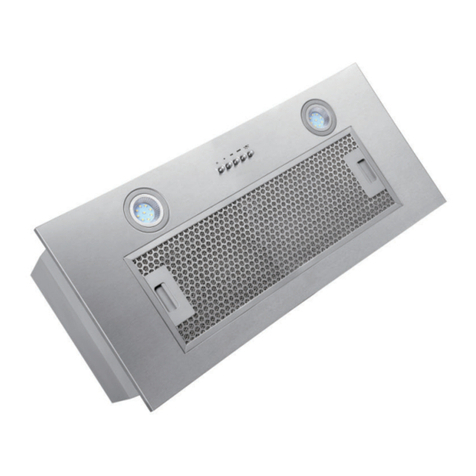
Lamona
Lamona LAM2303 Instructions and installation
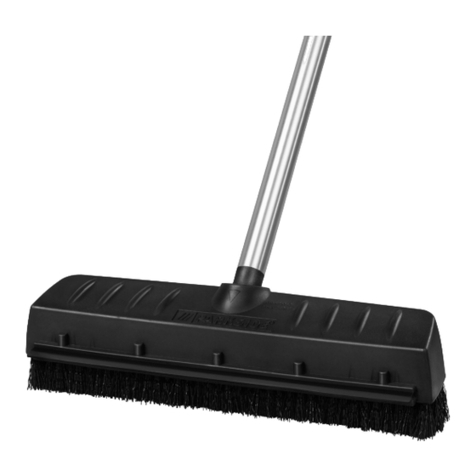
Parkside
Parkside 291645 Translation of the original instructions

JOHNY VAC
JOHNY VAC JVC70RIDER Operator's manual

Speaka Professional
Speaka Professional 98 93 46 operating instructions
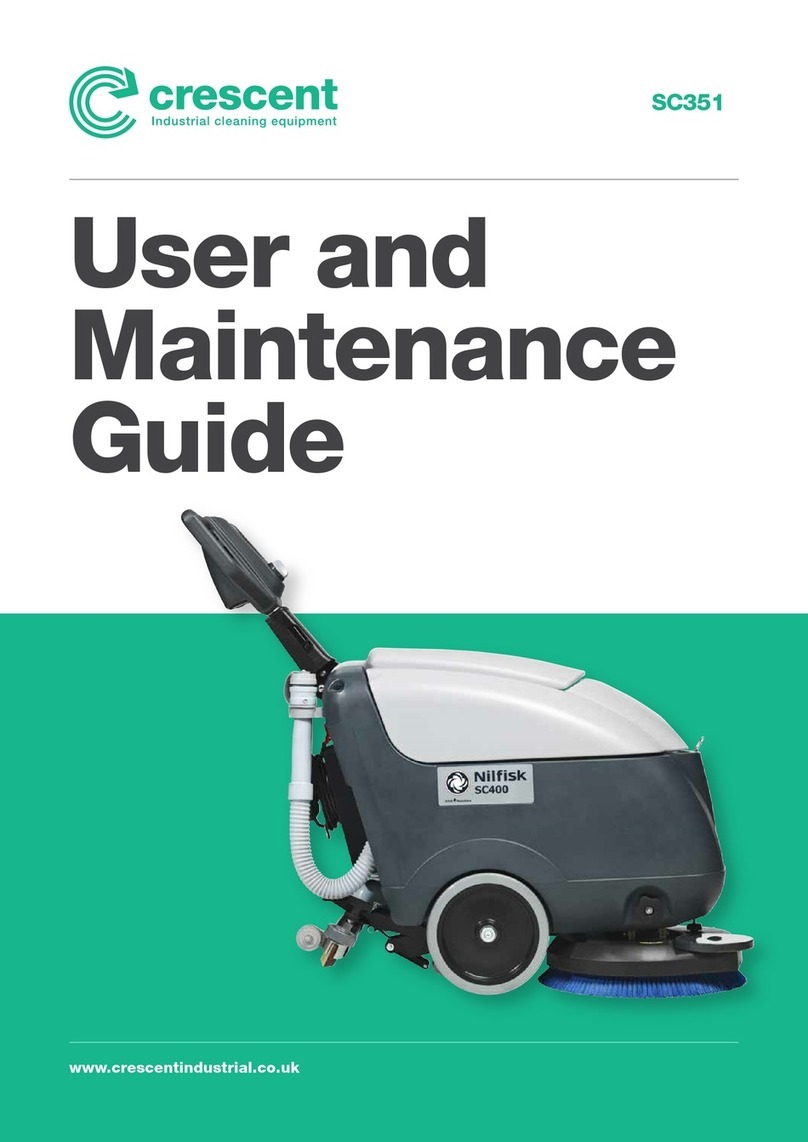
Crescent
Crescent SC351 User and maintenance guide

Arcora
Arcora 520BM manual

